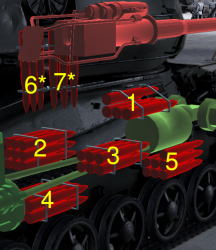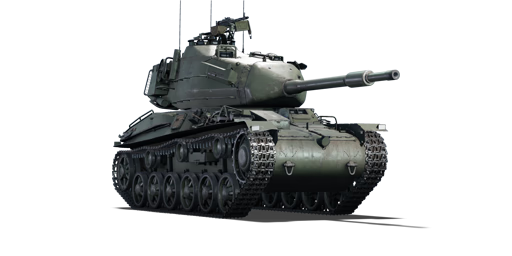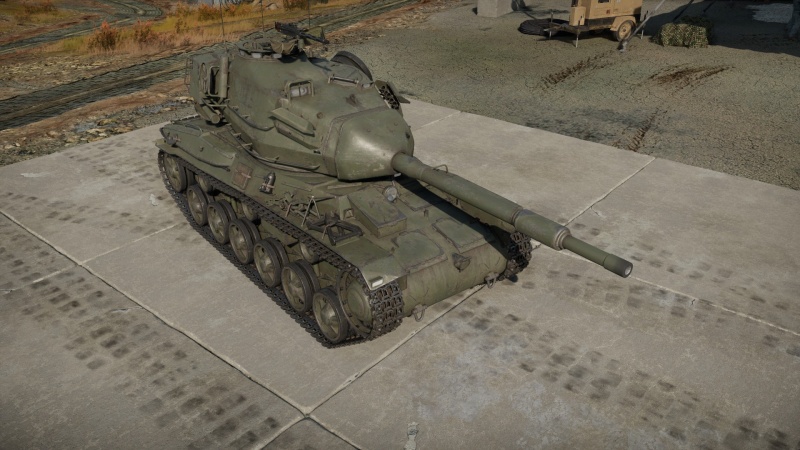Strv 74
Contents
Description
The Stridsvagn 74 was a Swedish light tank in service with the Swedish Army between 1958 to 1984. It was designed in 1957, using the older chassis of the Strv m/42 TH and TV that were considered obsolete in the mid 1950s. The Strv 74 was intended to support the recently acquired Strv 81. The turret was completely redesigned to be able to fit a high-velocity 75 mm tank gun based on a modified Lvkan m/37 anti-aircraft gun which was also to be used on the Pvkv II tank destroyer project. The Strv 74 served in armoured brigades up until 1967 when the Strv 103 took over the role and the Strv 74 was transferred to infantry support. The Strv 74 comes in two versions, 74 H and 74 V, their only difference being internal layout and transmission. The Strv 74 V would serve until 1981, and the remaining 74 H would serve until 1984 when they would be phased out in favour of the Ikv 91. The turrets would become coastal defences similar to the older Strv m/41 turrets that became static defenses around airfields.
Introduced in Update 1.97 "Viking Fury", the Strv 74 is a unique light tank developed primarily for combat in hilly terrain. With its excellent gun depression, this light tank can completely conceal the majority of its profile behind obstructions, revealing only its small turret to fight enemies when they are in sight. With its armour-piercing discarding-sabot (APDS) ammunition penetrating 247 mm of armour at point-blank range, players will be happy to learn that fighting even the strongest adversary on the battlefield is effortless. However, the light tank has a large profile, which is an issue on city maps. Furthermore, a lack of mobility combined with the slow reverse speed makes it difficult to retreat in difficult situations.
General info
Survivability and armour
Like the rest of the Swedish line, the armour on the Strv 74 should not be counted on to bounce a shot. It uses the same hull of the Strv m/42 (The Lago I)- a hull that at its BR the armour is considered fairly average. The new modern turret is extremely massive- almost the same size of the hull itself! This size makes hiding behind low objects impossible.
The turret does however have one niche trick up its sleeve, the back of the turret. An opponent who isn't well versed in the Swedish tree would assume the the back of the turret would house ammunition. However for the Strv 74, all the ammo (excluding the ready rack) is stored in the hull instead. With the inclusion of the 10 mm back plate, the turret back can act as a shot trap when caught off guard, allowing the Strv 74 to react accordingly - by returning fire or deploying one of the 2 smoke barrages and relocating.
Mobility
| Game Mode | Max Speed (km/h) | Weight (tons) | Engine power (horsepower) | Power-to-weight ratio (hp/ton) | |||
|---|---|---|---|---|---|---|---|
| Forward | Reverse | Stock | Upgraded | Stock | Upgraded | ||
| Arcade | 50 | 6 | 26 | 527 | 649 | 20.27 | 24.96 |
| Realistic | 45 | 5 | 301 | 340 | 11.58 | 13.08 | |
Modifications and economy
After Parts and FPE, it can be advisable to focus on mobility upgrades, given the Strv's poor power-to-weight ratio and top speed. Another useful modification is the 7,5 cm slpprj m/49 APDS shell, which gives this vehicle enough penetration to go through almost any armour that it might face.
Armaments
Main armament
| 75 mm kan Strv 74 | Turret rotation speed (°/s) | Reloading rate (seconds) | |||||||||||
|---|---|---|---|---|---|---|---|---|---|---|---|---|---|
| Mode | Capacity | Vertical | Horizontal | Stabilizer | Stock | Upgraded | Full | Expert | Aced | Stock | Full | Expert | Aced |
| Arcade | 40 | ±15° | ±180° | N/A | 17.1 | 23.7 | 28.8 | 31.8 | 33.9 | 8.71 | 7.70 | 7.10 | 6.70 |
| Realistic | 10.7 | 12.6 | 15.3 | 16.9 | 18.0 | ||||||||
Ammunition
| Penetration statistics | |||||||
|---|---|---|---|---|---|---|---|
| Ammunition | Type of warhead |
Penetration @ 0° Angle of Attack (mm) | |||||
| 10 m | 100 m | 500 m | 1,000 m | 1,500 m | 2,000 m | ||
| slpgr m/43 | APCBC | 158 | 154 | 139 | 122 | 107 | 94 |
| sgr m/38 | HE | 18 | 17 | 16 | 14 | 13 | 12 |
| slpprj m/49 | APDS | 247 | 243 | 227 | 208 | 191 | 176 |
| Shell details | ||||||||||||
|---|---|---|---|---|---|---|---|---|---|---|---|---|
| Ammunition | Type of warhead |
Velocity (m/s) |
Projectile mass (kg) |
Fuse delay (m) |
Fuse sensitivity (mm) |
Explosive mass (TNT equivalent) (g) |
Ricochet | |||||
| 0% | 50% | 100% | ||||||||||
| slpgr m/43 | APCBC | 925 | 6 | 1.2 | 14 | 110 | 48° | 63° | 71° | |||
| sgr m/38 | HE | 840 | 6.43 | 0.2 | 0.1 | 690 | 79° | 80° | 81° | |||
| slpprj m/49 | APDS | 1,160 | 2.6 | - | - | - | 75° | 78° | 80° | |||
Ammo racks

| Full ammo |
1st rack empty |
2nd rack empty |
3rd rack empty |
4th rack empty |
5th rack empty |
6th rack empty |
7th rack empty |
Visual discrepancy |
|---|---|---|---|---|---|---|---|---|
| 40 | 37 (+3) | 28 (+12) | 22 (+18) | 14 (+26) | 6 (+34) | 4 (+36) | 1 (+39) | No |
Notes:
- Racks 6 and 7 are ready racks and they will be filled going from rack 1 to 5.
Machine guns
The Strv 74 has a pair of 8 mm ksp m/36 machine guns, one mounted coaxially and the other mounted upon the commander's cupola. The machine guns have very low penetration and mass making it harder to use than some of its counterparts. They are best used deterring aircraft as your lightly armoured top is often the target of aircraft with heavy armament. The roof armament is immediately unusable if the commander has been killed or forced to take on the gunner or driver's position.
| 8 mm ksp m/36 | ||||
|---|---|---|---|---|
| Mount | Capacity (Belt) | Fire rate | Vertical | Horizontal |
| Coaxial | 4,000 (250) | 648 | N/A | N/A |
| Pintle | 2,000 (250) | 648 | -10°/+65° | ±180° |
Usage in battles
Protection:
Despite a decent amount of armour angling, the Strv 74 is weakly protected. Most enemy shells will be able to penetrate its armour with ease, which means that it is best to avoid enemy fire whenever possible. This vehicle is certainly no heavy tank, and rushing into risky situations, spearheading a push, or exposing the tank's profile is generally unadvisable. The tank's large side profile and tall turret make it quite visible on the battlefield as well, so it might not always be possible to find suitable cover.
Additionally, the internal layout of the vehicle is fairly cramped. With three crew members located in the turret, an APHE shell fired there can easily knock out enough crew members to destroy the vehicle. A shot fired into the front of the tank is likely to do the same. This makes it even more important to avoid enemy fire.
Firepower:
However, the tank's cannon is quite powerful, and able to punch above its weight, with a more-than-capable APHE shell. The upgraded APDS shell gives the gun enough penetration to go through almost any armour at this rank and makes it effective even in full uptiers.
The Strv has an outstanding -15 degrees of gun depression, which allows it to fire from behind ridges and hills that most other vehicles would never be able to utilise effectively. Be careful though: the tank has a prominent turret and a large turret cupola, which makes it difficult to fire from ridgelines without being spotted and fired upon.
Mobility:
The Strv has a low power-to-weight ratio compared to its peers, and a lower top speed as well. It can't zoom around the battlefield or quickly relocate like some vehicles can, and long flanking manoeuvres will also be difficult. The Strv 74 has a mediocre reverse speed, which should be noted when firing from behind ridgelines; the vehicle can be slow to reverse back behind cover after firing a shot.
Pros and cons
Pros:
- Incredible gun depression of -15°
- APDS round has 248 mm of penetration at 500 m
- Starts stock with the effective APCBC round found on the Pvkv II
- Quick gun elevation and depression
Cons:
- Turret is a massive target
- APDS shell is a tier IV modification
- Outdated chassis - narrow tracks and thin armour
- Slow reverse of -4 km/h
- Immensely reduced mobility due to increased weight
- Commanders machine gun reduces visibility to the right in simulator battles
- APHE has difficulty knocking out big heavy tanks with spaced-out crew
History
Development
After the end of World War 2, the only medium tank Sweden had was the Strv m/42. This vehicle was no longer capable, and had become obsolete. The Swedish military considered buying French AMX-13's, but decided to instead buy the British Centurion. Sweden had a need for a light tank still, and decided that designing a new light tank would take too long and be too expensive, so instead they decided to create a new light tank with the chassis of the Strv m/42. The Strv m/42 had been retired in 1950, and in 1953 the process of upgrading the tanks was started. First, putting the turret of the AMX-13 on the Strv m/42 chassis was considered but was quickly deemed unfeasible as the turret rings had different sizes and the necessary modifications would have made the project far too expensive and time consuming. Instead it was decided to develop a brand new turret. It was armed with a 7,5 cm lvkan m/36 anti-aircraft gun modified for use in a tank. The Swedish military supported this design because it would be cheaper than buying a foreign tank, and ordered two prototypes in 1954. The Strv m/42 EH was not chosen to hold the new turret as its engine was unreliable, but the Strv m/42 TH and TV were chosen to house the new turret.
Design
The turret had a unique shape, it was heavily sloped on all sides, but the armour was at most only 20 mm thick. The armour was kept to a minimum as the suspension would not be able to handle more weight. It shared many components with the Centurion. The back of the turret contained a Volkswagen engine used for heating and power. The gun could depress to an impressive -15 degrees. The chassis had to be modified in order to handle the increased weight of the new turret. The shock absorbers were replaced, the steering mechanism was changed, the driver's hatch was changed, and the tracks were widened to decrease ground pressure. The twin Scania-Vabis 603 engines of the Strv m/42 TH and TV were replaced by newer 607 engines featuring direct fuel injection, this increased the horsepower, and increased reliability at low temperatures. Smoke dischargers, a spare road wheel, and a bustle rack were added to the turret. The vehicle carried a crew of 4 men.
Production and Service
225 Strv m/74 were ordered by the Swedish military, and the order was spread between Hägglunds & Söner and Landsverk. There were two major variants, the Strv m/74 H (based on the Strv m/42 TH) and the Strv m/74 V (based on the Strv m/42 TV). The only major differences between the two was the different gearboxes which resulted in slightly different internal layout and ammo storage solutions. Both V and H variants were upgraded with spare Ra 121 or Ra 421 radios later in their service life and were redesignated as Strv 742 or 743 depending on the type of new radio they received. The Strv 74 was designated as a light tank until the 1960's, when it was re-designated as an infantry support vehicle. When the Ikv 91 entered service, the numbers of Strv 74 decreased as the Ikv 91 could do everything better than the Strv 74. The Strv 74 was fully retired from service by 1984, and some of the turrets were used as static fortifications until the late 1990's.
Media
- Skins
- Videos
See also
- Similar hull vehicles
- Similar role
External links
- Bibliography
- Loon, Milo van. (2019, December 26). Stridsvagn 74. Tank Encyclopedia. https://tanks-encyclopedia.com/stridsvagn-m-74/
- Stridsvagn 74. (2020, March 1). In Wikipedia. https://en.wikipedia.org/w/index.php?title=Stridsvagn_74&oldid=943382491
| AB Landsverk | |
|---|---|
| Light Tanks | |
| L-10 | Strv m/31 |
| L-60 | Strv m/38 · Strv m/39 · Strv m/40L |
| Pbil m/40 | Pbil m/40 |
| Strv 74 | Strv 74 |
| Unimog 404 | U-SH 405 |
| Medium Tanks | |
| Lago | Lago I · Strv m/42 EH · Ikv 73 · Strv m/42 DT |
| Tank Destroyers | |
| Ikv 72 | Ikv 72 · Ikv 103 |
| Pvkv m/43 | Pvkv m/43 (1946) · Pvkv m/43 (1963) |
| Pvkv II/III | Pvkv II · Pvkv III |
| SPAA | Pvlvv fm/42 · L-62 ANTI II |
| Sweden light tanks | |
|---|---|
| L-60 | Strv m/38 · Strv m/39 · Strv m/39 TD · Strv m/40L |
| Strv m/41 | Strv m/41 S-I · Strv m/41 S-II |
| Ikv 91 | Ikv 91 · Ikv 91-105 |
| CV 90 | Strf 9040B · Strf 9040C · Strf 9040 BILL |
| CV 90105 · CV 90120 | |
| Wheeled | Pbil m/40 · U-SH 405 |
| Other | Strv m/31 · Strv 74 · Pbv 501 |
| Finland | Vickers Mk.E · ▄T-26E · BT-42 · ▄PT-76 · CV 9030FIN · CT-CV 105HP |
| Denmark | CV 9035DK |





